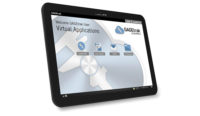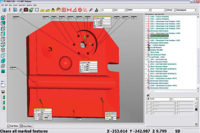Like so many other business software applications, calibration management software has evolved from very simple beginnings as a digital index card system that reminded operators when their instrument and tool calibration were due. During the past two decades, these systems have evolved and matured and are more comprehensive, analytical, scalable and secure than we have ever seen before.
Desktop application software refers to traditional application software that resides on a desktop or laptop computer. Microsoft Office is a familiar example.
The software is stored on the local hard drive and the data files are stored either locally or on a shared network drive. All of the processing takes place on the local computer. This type of system continues to make up the majority of commercially available calibration management systems and software in general. Not much has fundamentally changed other than user interfaces have vastly improved and the number of features has exponentially increased. Raw computing power, memory and storage have reached new levels of performance and have helped to offset most of the issues caused by huge software feature sets, large multi-user databases and data analysis routines.
This class of software continues to dominate not only in calibration management systems, but also in virtually all business application software. There are, however, other important options that are changing the way many companies use and purchase software. In fact, many software industry experts see these other options as becoming the norm during the next few years.
Calibration and Maintenance Apps Converge
Some organizations are looking to combine their calibration and maintenance software applications into a single unified system for easier management, improved compliance and lower costs. Other organizations have maintenance departments that are responsible for instrument calibrations as well as equipment and facilities maintenance; they are looking to bring together key operational processes and management systems.
FDA-regulated companies such as pharmaceutical, medical device and food manufacturers are required to validate their software applications prior to use, and it is much less complex and costly to validate one system rather than two.
Of course, some enterprise resource planning (ERP) systems such as those from IBM, Oracle, SAP and others already offer modules for both maintenance and calibration. For many, they tend to either be overly complex and expensive or too simplistic with very basic features. For some organizations, a combined calibration and maintenance system will save time, reduce training, combine key operational processes, reduce costs and increase productivity in managing all of their enterprise assets.
Web Application Software
Web application software is accessed and run through a Web browser. It can be run over a public network such as the Internet or within a private network such as the company intranet. Both the software application and data reside on the server and are presented through the operator’s Web browser. Common Web applications include banking, webmail, auctions and wikis.
Web applications are becoming popular in business, as Web browsers are found on virtually all computers. For company IT departments, Web applications are appealing because it is much easier and less costly to update and maintain Web applications on a few servers vs. distributing, installing and patching software on hundreds or perhaps thousands of desktop computers.
Although there are relatively few choices at present for Web-based calibration management software, this will be changing as more IT departments and individuals see the merits of running their business applications through a Web browser.
Most people have probably heard the term cloud computing. This is really just Internet-based use of computer technology. The technical details are masked from the individuals who no longer need to have expertise in the technology that supports them.
The term cloud is just a metaphor for the Internet, which is typically drawn as a cloud shape on network diagrams. Cloud computing providers deliver various business applications, which are typically accessed from a Web browser. Both the software and data reside on the providers’ servers.
In traditional software applications, individuals need to care about what operating system the application will require, such as Windows 7, UNIX, OS X, z/OS; hardware requirements such as hard drive space, CPU speed and RAM size; as well as the database system it requires to store records, including SQL Server, Oracle and DB2.
Cloud computing is a new delivery model for IT services and software that usually involves scalable and virtualized resources as a service over the Internet. Much like one’s electric service, it can scale to accommodate whatever is needed and the provider uses whatever resources-coal, solar, nuclear or wind-to generate the electricity. Individuals do not need to know the technical details and they probably do not even care-they just want the lights to go on when they flick the switch.
Benefits of Software as a Service
Software as a Service, or SaaS, is one of the application categories for cloud computing. The idea of running software remotely seemed ridiculous just a few years ago. There were far too many issues with bandwidth, browser incompatibilities, performance problems, unreliable Internet connections and security issues that made hosted software impractical, if not impossible.
Times have changed and today SaaS is growing at double-digit annual rates. In fact, it is expected to command more than a 20% market share of the $120 billion U.S. software market by the end of 2010.
With SaaS, costs can be greatly reduced and capital expenditures converted to operational expenses. This lowers barriers to entry, as infrastructure is typically provided by a third-party and does not need to be over-engineered and purchased for infrequent intensive computing tasks.
Pricing can be based on a utility model such as electric or cable TV service. The model is able to support usage- or time-based options; individuals just pay for what they need. Also, fewer IT skills are required for implementation and deployment by the end-customer.
Device and location independence enable individuals to access systems using a Web browser regardless of their location or what device they are using, whether it is a desktop, laptop or smart phone. Since the infrastructure is off-site and provided by a third-party, they can connect from anywhere access applications via the Internet.
Much like an apartment complex, condominium or hotel, “multi-tenancy” of servers and software applications enables sharing of resources and costs across a large group. This allows for centralization of infrastructure, lower operating costs, fewer IT staff and reduced electric costs. Also, peak-load capacity increases since individuals need not over-engineer for the highest loads as most systems are only 10% to 20% utilized.
Reliability improves through the use of multiple redundant host sites, which makes cloud computing suitable for business continuity and disaster recovery.
Scalability is achieved through dynamic on-demand provisioning of resources. Performance is monitored and can be adjusted to suit individuals’ needs.
Security can be seen as improved due to centralization of data and increased security-focused resources. In many cases security is often as good as or better than under traditional systems, in part because SaaS providers are able to devote more resources to solving security issues that many customers cannot afford.
Sustainability comes about through improved resource utilization, more efficient systems and lower carbon footprints. Traditional computers and associated infrastructure are major consumers of energy.
Maintenance of cloud computing applications is easier since the software does not have to be installed on each person’s computer. They are easier to support, update and switch since the changes reach the clients instantly at login time with no local software to install.
Drawbacks of SaaS
Of course, there are some drawbacks of SaaS.
Some feel that SaaS will force people to buy into locked, proprietary systems that will cost more and more over time. Examples include cable TV, telecom services and electric utilities that have virtual monopolies with few consumer choices.
Concerns exist about loss of control of certain sensitive data, especially in the military, government agencies, healthcare and FDA-regulated firms. Providers typically log user access activities, but accessing the audit logs themselves can be difficult or impossible. In addition, the complexity of security is greatly increased when data is distributed over a wider area or number of computers.
Some major cloud computing services have suffered outages, and IT and business managers can do little about it when they are affected. If the Internet goes down, so does the SaaS application. However, the same goes for electric and telephone services. Internet access continues to become more and more reliable-at some point this will not be any more of a concern than an electrical outage.
Mobile Apps and More
Just few years ago the typical computer user was tied to a desk and connected to data by cords and cables. During the last few years, wireless technology-including 3G cellular data networks and widespread Wi-Fi-has allowed for anytime, anywhere mobile software applications.
One major drawback has been the necessity to download data as needed, manage offline modes such as lost cell signal or Wi-Fi connection, and then ensure that all the data is synchronized with the host system.
Some calibration management systems now offer handheld PC, PDA and smart phone software modules that allow for truly portable and mobile calibration data collection and analysis.
Lightweight technologies such as gadgets and widgets have become popular on Web sites such as Google and Yahoo. Enterprises can use them to build quick tactical solutions and then slowly migrate to more strategic options. Windows Vista and 7 include a desktop gadget framework for individuals to check stocks, weather and news. Expect to see more and more application developers offer auxiliary gadgets for their applications that provide at-a-glance status on things such as calibration activities, service requests, work orders, staffing and inventory.
Many software firms are recognizing the importance of localizing applications and content across cultural and geographic boundaries. Although the technology has been around for a while to allow for this, the globalization of many enterprises is driving software localization forward. Companies are recognizing that both employees and partners operate more effectively in their native language rather than using English as a second language. For others it is the potential to sell outside of saturated English-language markets. Many software firms will lose market share in their assumption that application interfaces, user manuals and technical support need only support English.
As more applications move to the cloud, software and content will continue to expand to the farthest reaches of the globe, and it is important to remember that only 18% of the world’s population use English as their primary or secondary language.
Both Microsoft and Adobe will soon incorporate the “software plus services” concept as a bridge to SaaS. It is expected that these software giants will offer pure online-based software applications and will evolve, getting more and more of the features that are typically found on desktop application software.
Calibration management software has continued to evolve and change with the software industry in general. While individuals will not need to discard their desktop software anytime soon, it is good to be aware of choices that are available now and what the future holds.
Tech tips
-
For some organizations, a combined calibration and maintenance system will save time, reduce training and costs, and increase productivity in managing enterprise assets.
-
Cloud computing providers deliver various business applications, which are typically accessed from a Web browser. Both the software and data reside on the providers’ servers.
-
Some calibration management systems now offer handheld PC, PDA and smart phone software modules that allow for mobile calibration data collection and analysis.


